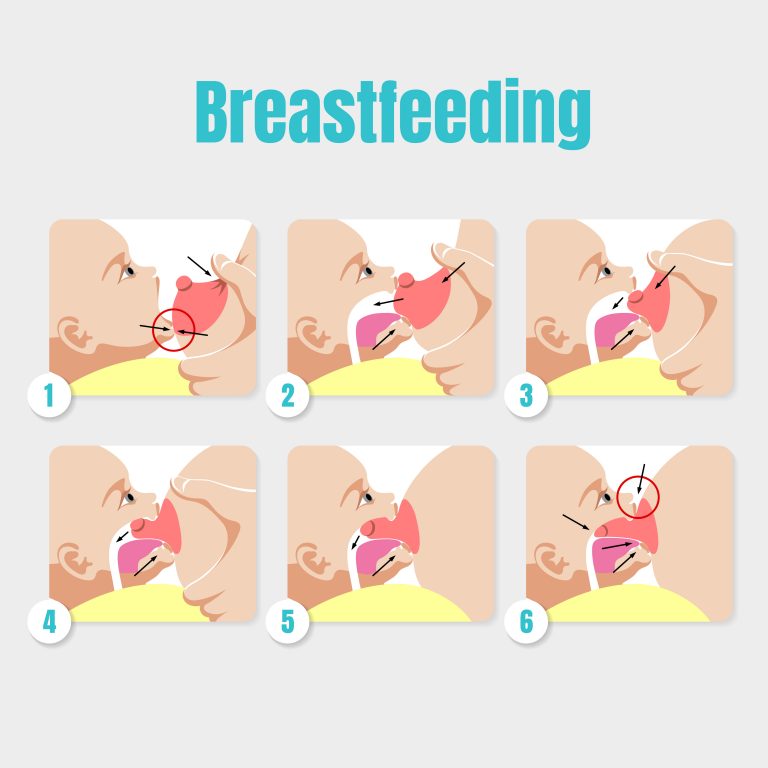Breastfeeding 101- Tips for First Time Mums

Getting Started with Breastfeeding
We’ve all been told of the many benefits of breastfeeding, both for mummy and baby. After all, breastmilk is nature’s way of providing a baby with the nutrition he requires. Breastfeeding may be daunting at the start but don’t give up. It may take some time for you and your baby to learn this new skill, but practice makes perfect, and both of you will be experts in no time!
When should you start breastfeeding? Ideally within 1-2 hours of birth, when baby is still very alert.
Let’s get down to some commonly asked questions about breastfeeding.
How Do I Hold My Baby to Nurse Him?

There are many ways to position your baby during breastfeeding, but the best position is one that is most comfortable for both of you. Here are three cradling methods you can try when nursing your baby:
- The Cradle Hold: Lay your baby across your chest, supporting his head with the forearm on the side of feeding, and his body and bottom with the other hand and arm.
- The Lying-Down Hold: This position may be good for night feeds. Lay your baby in bed facing you, with his mouth being on the same height as your nipple, or slightly lower. Position your baby’s lips toward the nipple closest to the bed. Place the arm that you are lying on under your head, or around your baby to support him.
- The Football Hold: For mums who have had a c-section, this hold may be more comfortable for you. Let your baby’s back lie along your arm. Your baby should be facing you. Guide your nipple to his mouth.
Remember to keep your shoulders, neck and arms relaxed. To help make you and your baby more comfortable, consider using adjuncts such as breastfeeding pillows or folded blankets and towels.
How Do I Latch My Baby Correctly?
Latching is a highly important aspect of breastfeeding. With a proper latch, your baby will get the milk he needs, and your breasts will be stimulated to produce more. A good latch also prevents your nipples from getting cracked and sore.

Step by Step Guide for A Good Latch
- Place your thumb and finger around your areola.
- Tilt your baby’s head back slightly and tickle his upper lip with your nipple until his mouth opens wide.
- Position your nipple slightly above your baby’s top lip. With his mouth wide open, his chin should touch your breast first and his nose should be clear.
- Aim the bottom lip of your baby away from your areola, leading him in chin first before latching onto your breast.. The lips should be curled outwards, His tongue should be extended, with your breast filling your baby’s mouth.
- When your baby has latched well, you should see significantly more of your areola above your baby’s top lip.
- As your baby feeds, his cheeks will appear plump and rounder, and you will hear him swallowing. You should not hear any clicking or smacking sounds.
How Do I Tell When My Baby Is Hungry?
With time, you will start to recognise some of your baby’s early feeding cues. These may include:
- Moving his Fist to his mouth
- Opening and closing his mouth
- Smacking his lips
- Turning his head towards the breast
- Making sucking noises
In the first month after birth, babies feed, on average, 8-12, or more times a day. This works out to be 2-3 hourly, counting from the start of one feed to the start of the next feed. Every baby is different. Some will feed very quickly, and others will take longer to finish their feed. It is more important to ensure they finish their feed as it is common for a newborn baby to fall asleep at the breast while feeding.
Here are some tips on how you can keep your baby awake until he has finished his feed:
- Partially undress your baby to allow more skin-to-skin-contact.
- Gently stimulate your baby by rubbing the soles of his feet, stroking his hand, or rubbing his back
- Change his diaper
- Burp him or switch to the other breast
How Do I Tell When My Baby Has Had Enough?
- He turns his head away from the nipple
- He starts to play, appearing disinterested
- His body starts to relax, and his fist may start to open
- His sucking slows down
- He starts to fall asleep
Once your baby has had enough, break the suction by pressing the breast near the mouth. Or gently inserting you finger into the corner of his mouth. Do not pull your breast out of baby’s mouth forcefully as this can cause injury to your nipple.
How Do I Tell If My Baby is Getting Enough Milk?
A few ways you can tell if your baby is getting enough milk:
- Steady weight gain
Losing some weight during the first week after birth is normal. After that, they should gain weight steadily. A baby generally doubles his birth weight by 6 months and triples his birthweight by his first birthday.
- Wet diapers
A newborn baby may not pass much urine initially, but this increases with each passing day. On day two, baby should be passing at two wet diapers over the 24 hour period, and by days three or four, he should be passing three or more wet diapers. By the time your baby is five days old, wet diapers should be more frequent, usually six or more a day.
- Passing Stools regularly
Your newborn should have at least 2 stools per day by day 4 of life, and the thick black meconium stools should give way to yellow stool of a seedy runny consistency. By 6 weeks old, your baby may pass stool once every 1-10 days.
- He should be alert and active when awake and developing appropriately.
If you have any questions or concerns, do reach out to your paediatrician or a lactation consultant for help and support.
Dr Andrea Yeo
Consultant Paediatrician
SBCC Baby & Child Clinic
Our Specialist
Dr Andrea Yeo is a Consultant Paediatrician at SBCC Baby & Child (Rivervale). Prior to joining SBCC, Dr Yeo was a former Consultant and Patient Safety Officer at the Children’s Emergency, Khoo Teck Puat-National University Children’s Medical Institute, National University Hospital, Singapore. She was also a Core Faculty Member of the NUHS Paediatric Residency Programme, and Assistant Professor at the Yong Loo Lin School of Medicine, National University of Singapore. She is experienced in managing general paediatric conditions and emergencies, and immunisations, growth and development assessments in infants and children.







